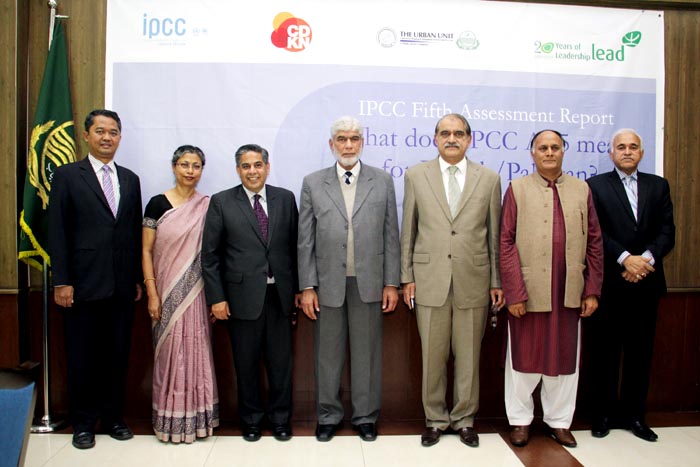What does IPPC’s Fifth Assessment Report mean for Punjab, Pakistan?
What does IPPC’s Fifth Assessment Report mean for Punjab, Pakistan?
Environmental journalist Rina Saeed Khan writes about the launch of the IPCC’s Fifth Assessment Report at the sub national level in Pakistan and the importance of its findings for climate compatible development in Punjab.
With the passing of the 18th Amendment to the Constitution of Pakistan subjects like the environment were devolved, giving increased power to provincial governments. There were fears at that time that provincial-level officials might lack the capacity and competency to deal with pressing issues like climate change, however at the recent presentation of the Intergovernmental Panel on Climate Change’s Fifth Assessment Report (AR5) findings by Asian IPCC authors to Punjab government officials in Lahore those fears seemed unfounded. “I am very impressed by the level of questions asked at the provincial level and clearly this meaningful discourse should continue”, remarked Ali Tauqeer Sheikh, CDKN Asia’s Regional Director and CEO of LEAD Pakistan. The audience comprised students and teachers of local government colleges and universities, officials from the Urban Unit, National Engineering Services Pakistan Limited (NESPAK) and the Planning and Development Department of the Punjab who had all gathered to hear from the experts what the IPCC’s latest scientific report had to say about the Asian region.
[caption id="attachment_48344" align="aligncenter" width="700"]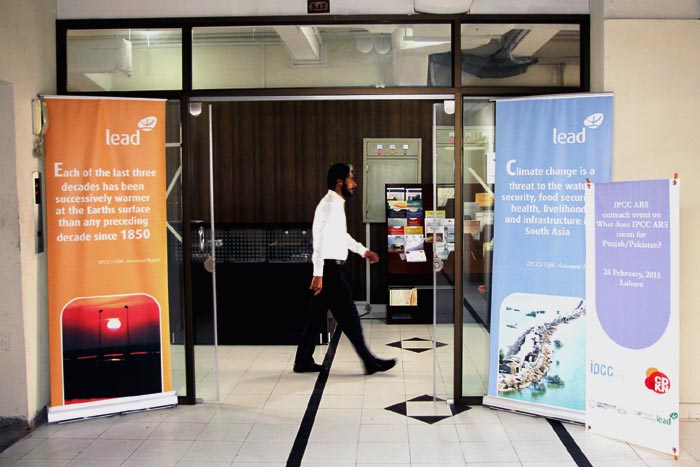 The one-day programme, held at the Punjab Government’s Planning and Development Department building on February 24th 2015, was organised by the Climate and Development Knowledge Network (CDKN) in collaboration with the IPCC.[/caption]
The one-day programme, held at the Punjab Government’s Planning and Development Department building on February 24th 2015, was organised by the Climate and Development Knowledge Network (CDKN) in collaboration with the IPCC.[/caption]
The one-day programme, held at the Punjab Government’s Planning and Development Department building on February 24th 2015, was organised by the Climate and Development Knowledge Network (CDKN) in collaboration with the IPCC. It was the first sub-national event held in Pakistan on the key findings of AR5 from Asia’s perspective and initiated dialogue on what the IPCC’s AR5 synthesis report in the context of Asia means for the immediate and long term future of the province and the country.
Ali Tauqeer Sheikh pointed out in his opening remarks that the IPCC’s latest assessment report involved thousands of scientists and at the end,every word agreed was endorsed by governments. The IPPC does not do new research, but presents a summary of existing scientific reports. He lamented the fact that there is little input from developing countries and that global (climate) models lose relevance when you come down to the local level. He introduced the three Asian IPCC authors on the panel: Dr Joyashree Roy from India, Dr Edvin Aldrian from Indonesia and Dr Muhammad Mohsin Iqbal from Pakistan.
[caption id="attachment_48345" align="aligncenter" width="700"] "There is little input from developing countries and that global (climate) models lose relevance when you come down to the local level" Ali Tauqeer Sheikh, CDKN Asia’s Regional Director and CEO of LEAD Pakistan[/caption]
"There is little input from developing countries and that global (climate) models lose relevance when you come down to the local level" Ali Tauqeer Sheikh, CDKN Asia’s Regional Director and CEO of LEAD Pakistan[/caption]
Dr. Iqbal from the Global Change Impact Study Centre in Islamabad is in fact the only author from Pakistan to contribute to AR5 in the “Food Security and Food Production Systems” chapter of the Working Group II report. He pointed out that the evidence is clear now that the Earth’s climate system has significantly changed since the pre industrial era with large part of the changes being anthropogenic (caused by humans). According to AR5, the increase in average global temperature was 0.6 degrees C in the last 100 years and in first 12 years of this century it has gone up to 0.8 degrees C. There are now projected increases of 4 to 5 degrees, and it may even go up to 6 degrees C (which would prove to be disastrous).
[caption id="attachment_48349" align="aligncenter" width="700"]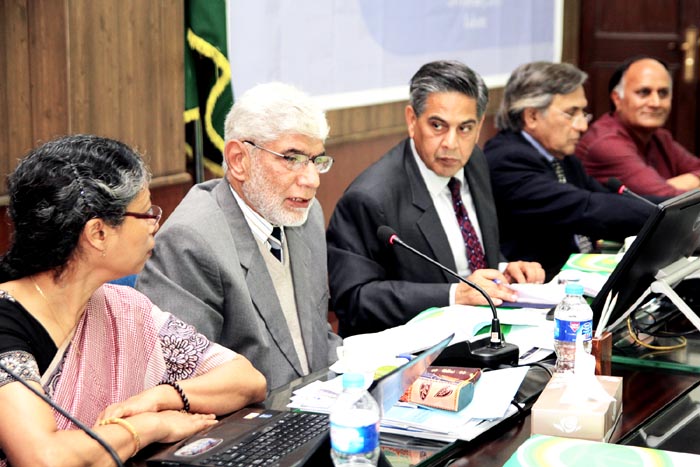 "The increase in temperature in Pakistan is higher than the average global temperature increase and that the temperature increase in northern Pakistan is higher than in southern Pakistan" Dr Mohsin Iqbal, author from Pakistan to contribute to AR5 in the "Food Security and Food Production Systems" chapter of the Working Group II report.[/caption]
"The increase in temperature in Pakistan is higher than the average global temperature increase and that the temperature increase in northern Pakistan is higher than in southern Pakistan" Dr Mohsin Iqbal, author from Pakistan to contribute to AR5 in the "Food Security and Food Production Systems" chapter of the Working Group II report.[/caption]
Dr Iqbal pointed out that the increase in temperature in Pakistan is higher than the average global temperature increase and that the temperature increase in northern Pakistan is higher than in southern Pakistan. Precipitation has also increased slightly in the summer and decreased in winter; although there has been no change in annual precipitation. There have also been changes in the glaciers located in the Eastern Himalayas, which are melting. While those located in Pakistan are likely to lose mass, there have been reports of expansion of some glaciers in the Karakorams. There has also been an increase in climate induced extreme events – an increase in heat waves, droughts, floods, cyclones and wildfires. In Pakistan the frequency and intensity of extreme events has increased; there were super floods in 2010 and 2011 and back-to-back floods in 2011, 2012, 2013 and 2014. There have also been droughts, intense heat waves and severe cyclonic storms in the country. All aspects of food security are potentially affected by climate change. The growing season length would be shortened due to increasing temperatures and there would be losses in yields.
[caption id="attachment_48352" align="aligncenter" width="700"]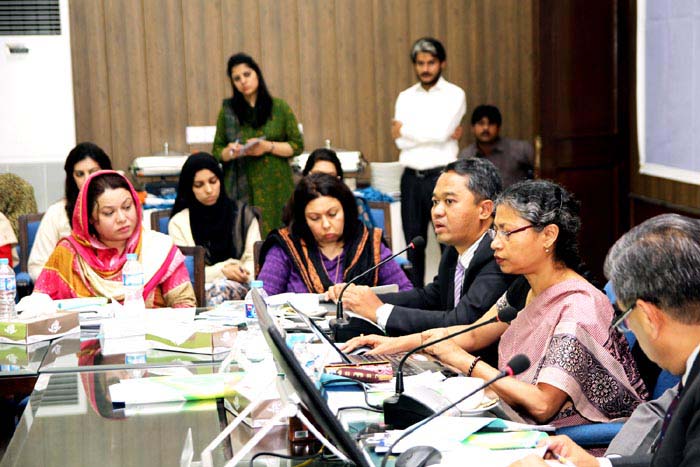 "The IPCC, he explained, has tried to separate human causes from natural causes when it comes to global warming" Dr Edvin Aldrian from Working Group I.[/caption]
"The IPCC, he explained, has tried to separate human causes from natural causes when it comes to global warming" Dr Edvin Aldrian from Working Group I.[/caption]
Dr Edvin Aldrian from Indonesia described how human activity is changing the global climate. He pointed out that the growth of economies is highly correlated with emissions. The wealthier economies have higher emissions. The IPCC, he explained, has tried to separate human causes from natural causes when it comes to global warming. Scientists have found that warming is consistent with that expected from anthropogenic factors and inconsistent with that expected from natural factors. Dr Aldrian is from Working Group 1, which deals with the physical science of climate change in the report.
Dr Joyashree Roy from India focused on what AR5 tells us about the action the world must take. As a lead author who has contributed to Working Group III’s report on mitigation, she pointed out that amongst the key IPCC messages is that without assistance, it is hard to embark on a low carbon pathway and current world efforts are just not sufficient. The Cancun pledges (agreed by the world at Cancun during the UN Climate Change Conference 2010) are inconsistent with reaching the 2 degrees Celsius goal (to limit global warming) agreed upon by countries in Copenhagen in 2009. She pointed out several options for industries in mitigation: energy efficiency, selecting better materials, improved product design, increasing the lifetime of materials produced, reducing whole demand etc.
[caption id="attachment_48355" align="aligncenter" width="700"]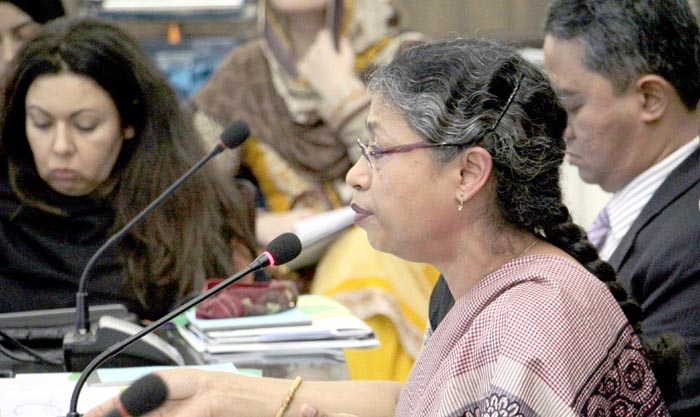 "Without assistance, it is hard to embark on a low carbon pathway and current world efforts are just not sufficient" Dr Joyashree Roy from Working Group III.[/caption]
"Without assistance, it is hard to embark on a low carbon pathway and current world efforts are just not sufficient" Dr Joyashree Roy from Working Group III.[/caption]
She pointed out that energy efficiency could be increased to 45% in some countries where best practices are not happening. There are also low energy building codes to lock in, or retrofit with 50 to 90% reduction potential, lifestyle changes, and introduction of traditional architecture, which can result in 20 to 50% reductions in emissions in the building sector.She added that urban areas are major contributors to more than half of the global primary energy use and energy related carbon dioxide emissions. “We could make wise choices in developing countries in South Asia; and the largest opportunities lie in rapidly urbanising countries”. She explained that what is needed is a cross-sectoral approach. “In AR5 there is no single pathway for development; we need to make our own choices”. She pointed out the need for developing countries like Pakistan to generate their own knowledge, do their own studies and strengthen policy makers and negotiators.
In his concluding remarks, Ghulam Rasool, the Chief Meteorologist of Pakistan summarised that: “The country has faced 5 years of continuous floods and right now our policy is not addressing these challenges at the pace that climate change is happening. The lagging behind will cost us seriously in damages… This is the right time to integrate climate change and policy – the National Climate Change Policy was approved in 2012 and now there is a dire need for provincial policies; the Punjab should take the lead to develop its own policy.” The Punjab government officials responded that they would like to continue with these discussions and learn more. Dr Nasir Javaid of the Punjab Government’s Urban Unit, stated that: “The key lesson for Pakistan is that 50% of our urban structure is yet to be built and if we adapt keeping in view climate change challenges we can be better off”.

